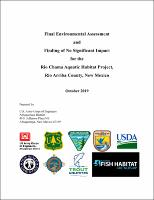Please use this identifier to cite or link to this item:
https://hdl.handle.net/11681/42325| Title: | Final Environmental Assessment and Finding of No Significant Impact for the Rio Chama Aquatic Habitat Project, Rio Arriba County, New Mexico |
| Authors: | United States. Army. Corps of Engineers. Albuquerque District |
| Keywords: | Rio Chama (Colo. and N.M.) Aquatic habitats Environmental protection Environmental management |
| Publisher: | United States. Army. Corps of Engineers. Albuquerque District. |
| Abstract: | The purpose of the proposed action is to improve fish and wildlife habitat conditions on the Rio Chama, and support increasing sport fish and wildlife recreation by the public. Trout fishing is popular on the Rio Chama downstream of Abiquiu Dam. Currently, the tailwater river channel immediately below Abiquiu Dam has limited aquatic habitat and structure for fish, and riparian vegetation providing leaf litter for aquatic insects. Historically, the Rio Chama supported a resilient ecosystem with diverse aquatic and riparian habitat. The Rio Chama downstream of Abiquiu Dam has been affected by channel degradation and loss of riparian habitat following dam construction. The channel has become hardened with coarser sediment, reducing aquatic habitat complexity. Flood operations limit the safe channel capacity flow to levels lower than the existing terrace elevation downstream of the dam necessary to support native riparian vegetation recruitment. As a result of incision and other changes, areas of healthy native riparian habitat, including wetlands, are rare and scattered in the project area. Loss of riparian habitat is an important conservation issue in the arid Southwest. The NMDGF released its most current iteration of the Statewide Wildlife Action Plan (SWAP) for New Mexico in 2016 (NMDGF 2016). This plan identifies species of greatest conservation need, threats to the status of those species, and potential management actions to conserve those species. The project area is located within the Colorado Plateau Ecoregion. While numerous species of conservation need are identified for this Ecoregion, only Rio Grande Chub and northern leopard frog are likely to be affected by this project. Riparian and aquatic habitat manipulation to favor native species of concern is identified in the SWAP as an important tool for conservation of native fish and amphibians. Modification of existing aquatic habitat within this reach can benefit both species via establishment of aquatic macrophytes, creation of low current refugia, and development of off channel ponding. The New Mexico Wildlife Center uses the project area to conduct hands-on place-based experiential science education for students from numerous schools in the Española school district, as part of their River Class program. The program has collected water quality data and aquatic macro-invertebrates, with a goal of providing baseline data that can be compared to future surveys to quantify post-project results. |
| Description: | Environmental Assessment and Finding of No Significant Impact |
| Rights: | Approved for Public Release; Distribution is Unlimited |
| URI: | https://hdl.handle.net/11681/42325 |
| Appears in Collections: | Environmental Documents |
Files in This Item:
| File | Description | Size | Format | |
|---|---|---|---|---|
| Final_Environmental_Assessment_Rio_Chama_Aquatic_Habitat_2019.pdf | 34.36 MB | Adobe PDF |  View/Open |